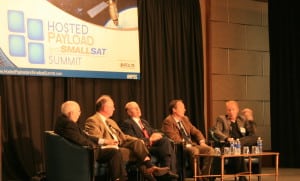ViviSat MEVs Join Growing List of Hosted Payload Launch Opportunities

Panelists David Anhalt, VP and general manager, Iridium Prime, Iridium Communications; Jim Armor, VP of ATK Space Systems Division; Curt Blake, president, Spaceflight Inc; Kirk Woellert, external payloads manager, NanoRacks. Photo: Access Intelligence
[Via Satellite 10-21-2014] ViviSat will soon begin orbiting a constellation of Mission Extension Vehicles (MEVs) with room to carry hosted payloads into Geosynchronous Earth Orbit (GEO). Jim Armor, Vice President, ATK Space Systems Division, which has invested in the in-orbit servicing venture, as has U.S. Space, said they are planning regular launches starting in three to four years.
“We’re looking at dual launching two Mission Extension Vehicles every 18 months, keeping a fleet of 10 or more and growing capabilities over time to operate in satellite servicing, perhaps refueling, perhaps battery power,” Armor said Oct. 15 at the Hosted Payload and SmallSat Summit.
ViviSat’s MEVs dock with spacecraft for three to five years at a time before providing service to other customers. In June ViviSat COO Bryan McGuirk told Via Satellite the company has confirmed orders for the first three MEVs. Hosted payloads that fly with ViviSat also benefit from the company’s commercial remote sensing license, which Armor said was a requirement to use the remote operation cameras for docking MEVs with satellites because Earth would be visible. Each vehicle has a lifespan of 16 years, and has room for several hosted payloads, though Armor said they are not dependent on them for any missions.
Speaking at the same event, Iridium’s VP and General Manager of Iridium Prime, David Anhalt said the hosted payload offerings on Iridium NEXT have seen robust success. Roughly 200 hosted payloads will fly on the new satellites as they launch between 2015 and 2017. Consequently, Iridium came to the realization that more opportunities would allow the company to extend this remunerative business, he said.
Iridium NEXT is comprised of 66 active satellites and nine in-orbit spares. To continue offering hosted payload options to customers, Iridium Prime leverages the same commodity bus design with inter-satellite links, but without the same communications payload.
“That frees up over 200 Kg of mass that can now be made available. So starting in the year 2017, or late 2018 there will be a regular pipeline of opportunities for hosted payloads to be placed into our Low Earth Orbit,” said Anhalt. “We believe we can operate as many as 66 Iridium Prime satellites.”
Both ViviSat and Iridium said that they had borrowed pages from Spaceflight Inc. — a company that buys up excess capacity on launch vehicles to sell to SmallSat operators — when it comes to providing guidelines to ensure success in fitting launch architectures. Curt Blake, president of Spaceflight said the shortage of affordable launches on the SmallSat front has been exacerbated by both ITAR and the current Russia-Ukraine conflict.
“There’s just not enough capacity on U.S. launch vehicles at an acceptable price point that works,” he said, adding that Spaceflight has “been contemplating working towards buying launch vehicles” of its own. These vehicles would provide room for hosted payloads too, he said.
Spaceflight has deployed 76 payloads since its founding in 2010. Blake said roughly 120 more payloads are currently under contract. Several of those payloads have been deployed in partnership with NanoRacks, whose CubeSat deployers on the International Space Station (ISS) have enabled Planet Labs and others to launch SmallSats into Low Earth Orbit (LEO). But the ISS has been operating at close to full capacity, and its lifespan past 2020 is currently a subject of debate.
“The Space Station is not our only game,” Kirk Woellert, external payloads manager at NanoRacks assured. “We are looking at other venues, because this is a logical stepping stone [in our] incremental approach to expanding the ecosystem we have in LEO.”
Panelists expressed a mix of enthusiasm and concern regarding the rapidly growing number of startups touting dedicated SmallSat launchers. This year alone has seen Firefly Space Systems’ Firefly Alpha, Rocket Lab’s Electron and Zero2infinity’s Bloostar. Spaceflight said they are working with some of these the new companies, but is waiting to see if they have a strong enough business cases to succeed.